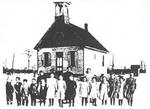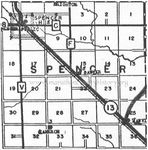Spencer Wisconsin History
Spencer,Wisconsin is located in Central Wisconsin's Marathon county, the village was founded in 1904 at a branch on the Soo Line railroad. Spencer lies between two marshes. The Spencer Marsh to the northwest and McMillan Marsh, including the McMillan Reservoir on the Little Eau Pleine River, to the southeast.
SPENCER TOWNSHIP
Spencer Township was founded in 1871 and established in 1877. Homesteaders began filing claims to the wooded acres around 1871. Records show the first settlers were Reuben Ring and his family. On January 3, 1871, Rueben had entered a claim in the U.S. Land Office for the N1/2 of NW 1/4, Section 7, Township 26 North Range 2 East.
The townships first public official was John K. Hayward.
Hayward was the second white settler to arrive in Spencer. He was born in St. Lawrence County, NY and came to Waupaca County with his parents when he was 14 years old. He arrived in Spencer in 1872, put up a log house and sent for his wife, Rachel Amanda (Blazer), and his six daughters. He later built a large frame house, in time for the birth of the second of his five sons.
The Wisconsin Central Railroad was completed in the early 1870s. It entered the township on the southeast corner and ran practically exactly diagonally through the township. The coming of the railroad was instrumental in the development of Spencer by bringing settlers and mill owners to the area.
Early settlers moved to the area on ox-drawn vehicles through rough trails in the woods. First they would build a log home and a shelter for the animals. Next they would plant a small garden to produce enough food to get them through the winter.
In the many years to follow, they would clear the large pine stumps from their land so that they could plant their crops and work on producing a herd of dairy cattle. As the farm grew, log houses were replaced with larger framed houses.
It has been said that the railroad and lumber mills gave Spencer its beginning, but it was the hard working farmers that kept it going after the mill owners moved north.
Spencer Village
The Village of Spencer was first known as Waltham. The name was changed from Waltham to Spencer July 27, 1874 by John K. Hayward.
Mr. Hayward was the villages first postmaster and he was also the superintendent for the building of the road bed for the Wisconsin Central.
He built a shanty and began brushing six miles of railroad northward from Section 35. Near this shanty he erected a depot made of ties and called the place Waltham. The depot made of ties was later replaced by a larger wooden structure located to the North. After it burned down another was built east of the tracks and in 1901 was moved west of the tracks.
The depot was a busy place and many times it was filled to capacity as passengers waited to change trains. People in the area were known to spend Sunday afternoons at the depot observing all of the activity.
In 1873, the Rev. W. C. Schilling of Stevens Point came to Spencer on a mission trip. He was the first Lutheran pastor to serve settlers in the area. Services were held in a log school house on the Naatz farm north of Spencer.
St. John's congregation was organized on October 27, 1878. The first catholic church was built in 1883 on the east side of Spencer. A fire destroyed this church in 1886. Trinity Lutheran Church was organized on May 21, 1882. Services were held in the Spencer Town Hall before the first church was erected. There is no record as to the organization of the United Methodist Church, but it must have been prior to the building of the first church c. 1879. The Baptist church held religious services in Spencer as early as 1875 in the basement of school.
As early as 1877 there were four large saw mills situated in the site of the present village. The saw mills pulled out one after another as the timber vanished, until all had disappeared. But in nearly the same degree as the mills and the mill population decreased, the farming settlement increased, and while the village lost, the town gained year after year, and Spencer village became a good country village.
"Scorched Again! Nearly Half the Town Burned" was the headline in the Spencer Tribune on Monday, August 9, 1886. Reportedly, several days prior to the August 8, 1886 disaster, a fire had broke out on the property of D. F. Cressy which was located southwest of the village. As the days passed, the fire moved closer to the south side of the Village.
On Sunday, August 8, 1886 it roared into the village burning many buildings, churches, schools and houses along the way. Mayor Upham and the citizens of Marshfield brought supplies and offers of homes for the victims. Although Spencer did not die as many lumber towns had after such an experience, the fire did bring the beginning of the end of the lumber business in the area.
A Map Depicting Spencer's Three School Districts
The first school was a small building west of the railroad tracks in the fall of 1874.
The first school building was erected in 1875 for School District 1, Town of Spencer. This building was replaced several times over the years for many different reasons. In 1915 and 1916 a two-story brick school building was built on the same site to serve as both the grade school and the high school. This facility served the community until 1951 when new facilities were added.
The town was divided into three school districts. Mannville School, School District 2 was in Section 25; Cameron School, School District 3 was in Section 33; Sawyer School, School District 6 was in Section 15. The first Mannville School was built in 1875 and closed in 1956. Cameron School was built in 1903 and closed in 1956. The Sawyer school was closed in 1946.





